Dive into the fascinating world of dolphins with this 21-question quiz! Test your knowledge about these intelligent marine mammals, from their unique adaptations to their social behaviors. Dolphins have captivated humans for centuries with their playful nature, complex social structures, and remarkable intelligence. Found in oceans and rivers around the globe, these cetaceans have evolved a wide range of adaptations that allow them to thrive in diverse aquatic environments.
1. What is the average lifespan of a bottlenose dolphin in the wild?
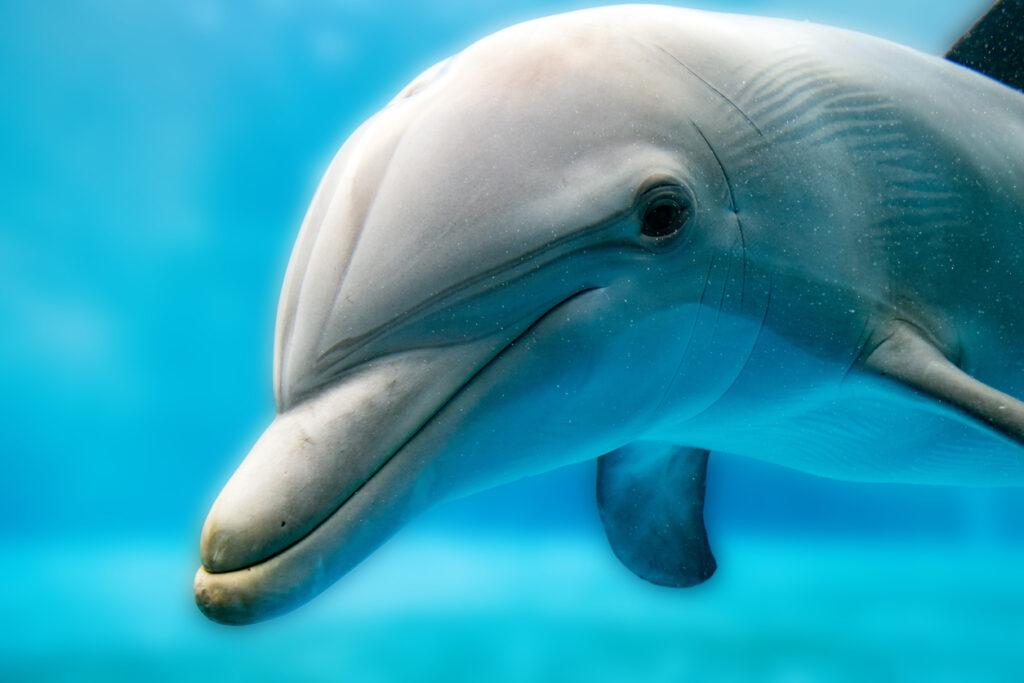
Dolphins are known for their relatively long lifespans compared to many other marine animals. Their longevity is influenced by various factors, including environmental conditions, food availability, and human activities. In captivity, dolphins often live longer due to regular veterinary care and protection from predators.
A) 5-10 years
B) 20-30 years
C) 40-50 years
D) 60-70 years
Answer: B)
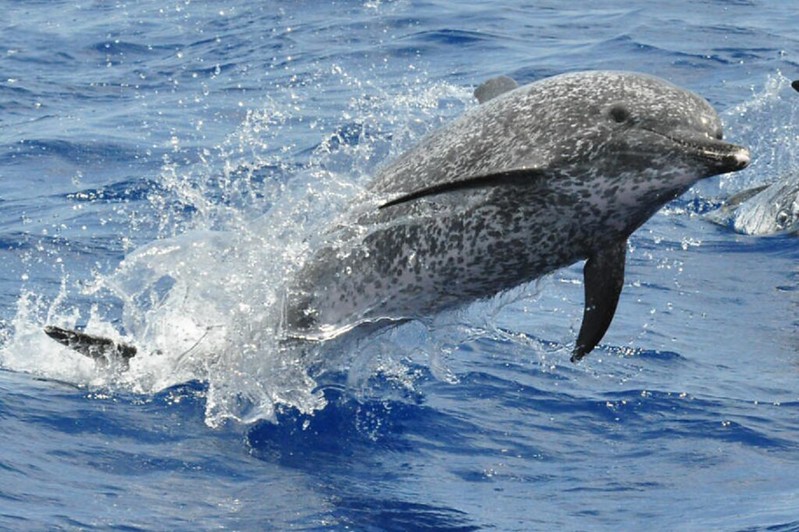
The average lifespan of a bottlenose dolphin in the wild is 20-30 years. Some individuals can live up to 50 years or more. Factors affecting lifespan include environmental conditions, food availability, and human activities. In captivity, they may live longer due to regular care and protection from predators.
Dolphins, like many long-lived mammals, have a relatively slow reproductive rate. Females typically give birth to a single calf every 3-6 years, investing significant time and energy in raising their young. This long lifespan and extended parental care contribute to the complex social structures and behaviors observed in dolphin populations.
2. Which part of a dolphin’s body is used for echolocation?
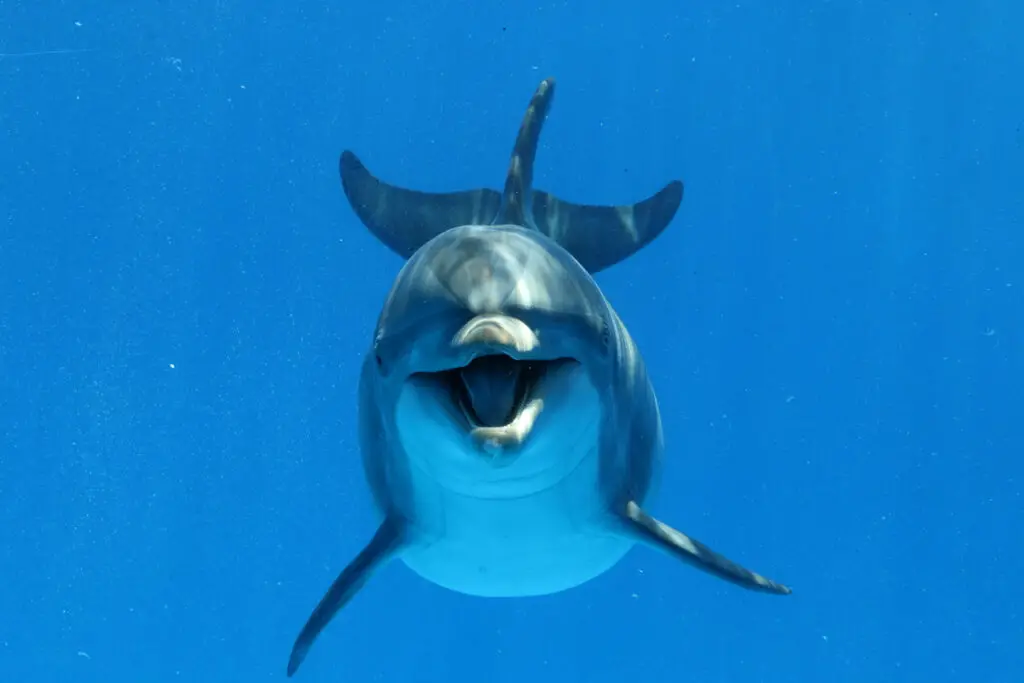
Echolocation is one of the most remarkable abilities of dolphins, allowing them to navigate, communicate, and hunt in various aquatic environments. This biological sonar system is a prime example of how evolution has shaped these marine mammals to excel in their underwater world. Understanding the mechanics of echolocation provides insights into the sophisticated sensory capabilities of dolphins.
A) Tail
B) Fins
C) Melon (Forehead Area)
D) Eyes
Answer: C)
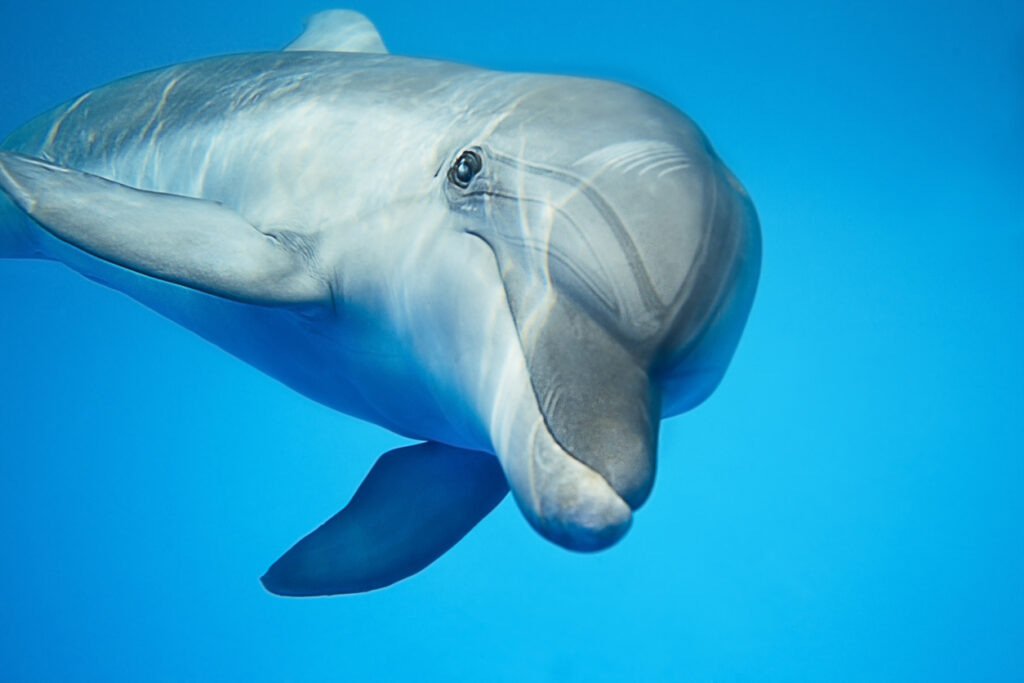
The melon, a fatty organ in the dolphin’s forehead, is used for echolocation. It focuses high-frequency sounds (clicks) into a beam that the dolphin projects forward. When these sound waves hit an object, they bounce back as echoes. The dolphin receives these echoes through its lower jaw and processes them in its brain to create a “sound picture” of its surroundings.
This remarkable ability allows dolphins to detect objects as small as a ping pong ball from over 100 meters away. Echolocation helps dolphins navigate in dark or murky waters, find food, and communicate with each other. It’s a prime example of how evolution has equipped these marine mammals to thrive in their underwater environment.
3. True or False: All dolphin species live in the ocean.
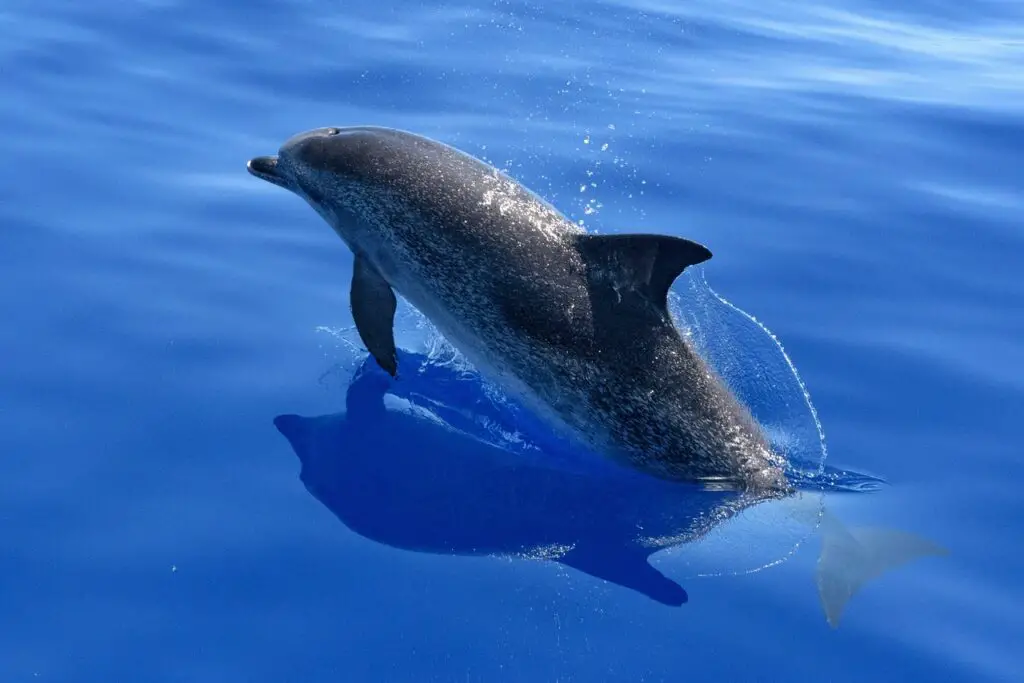
When we think of dolphins, we often picture them leaping gracefully through ocean waves. The habitats of these remarkable creatures are more diverse than many people realize. Understanding the range of environments where dolphins can be found is crucial for appreciating their adaptability and the conservation challenges they face.
Answer: FALSE

False. While most dolphin species live in oceans, some inhabit freshwater environments. Examples include the Amazon River dolphin, Ganges River dolphin, and Indus River dolphin. These species have adapted to life in rivers and face unique challenges compared to their oceanic counterparts, often being more vulnerable to human activities.
Freshwater dolphins face unique challenges compared to their oceanic counterparts. They often have more limited ranges and are more vulnerable to human activities such as dam construction, pollution, and fishing. As a result, many freshwater dolphin species are endangered.
4. What is a group of dolphins called?
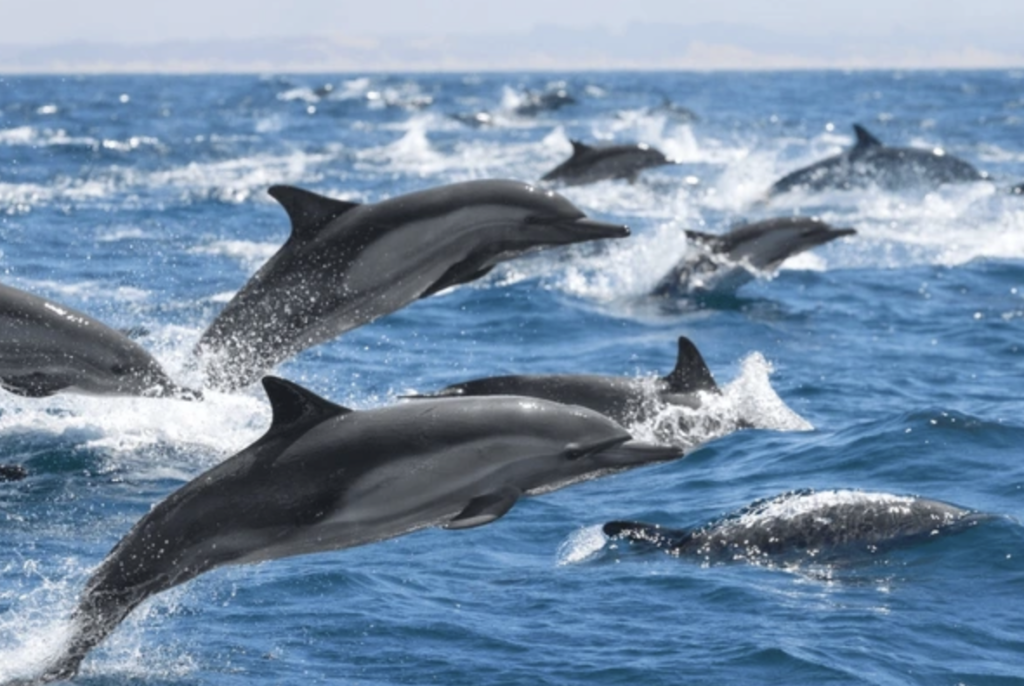
Dolphins are highly social animals, known for their complex interactions and group behaviors. The way they organize themselves in the wild provides fascinating insights into their social structure, communication methods, and survival strategies. Understanding how dolphins group together is key to appreciating their intelligence and the importance of social bonds in their lives.
A) Herd
B) Pod
C) School
D) Flock
Answer: B)
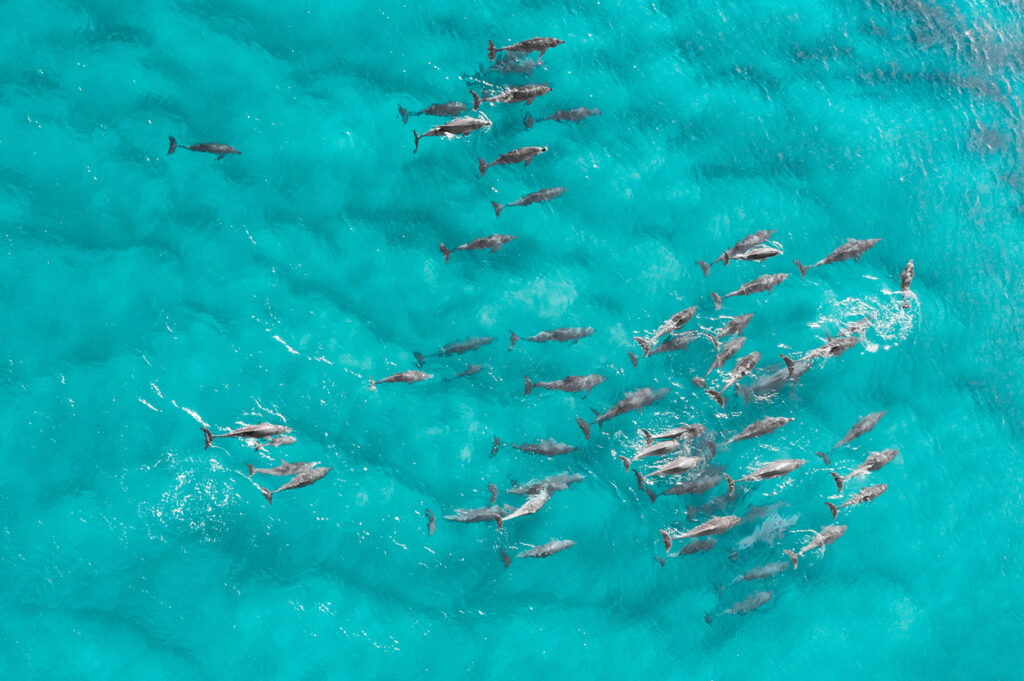
A group of dolphins is called a pod. Pod sizes vary greatly, from a few individuals to hundreds, depending on the species and environmental conditions. These social groups play crucial roles in dolphin behavior, providing protection, facilitating hunting, and supporting complex social interactions within the group.
Within a pod, dolphins form strong social bonds and exhibit cooperative behaviors. They communicate using a variety of vocalizations, body language, and even physical contact. Some dolphin species, like the bottlenose dolphin, have been observed forming “alliances” within their pods, which are long-term cooperative relationships between individuals.
6. How do dolphins sleep?

Sleep is a crucial biological function for all animals, but for air-breathing mammals that live in water, it presents unique challenges. Dolphins have evolved a fascinating solution to the problem of sleeping while needing to surface regularly to breathe. This question explores one of the most intriguing aspects of dolphin biology, revealing how these intelligent creatures have adapted to balance the need for rest with the constant demands of their aquatic lifestyle.
A) They don’t sleep at all
B) They sleep with both eyes closed
C) They sleep with one eye open
D) They sleep on the ocean floor
Answer: C)
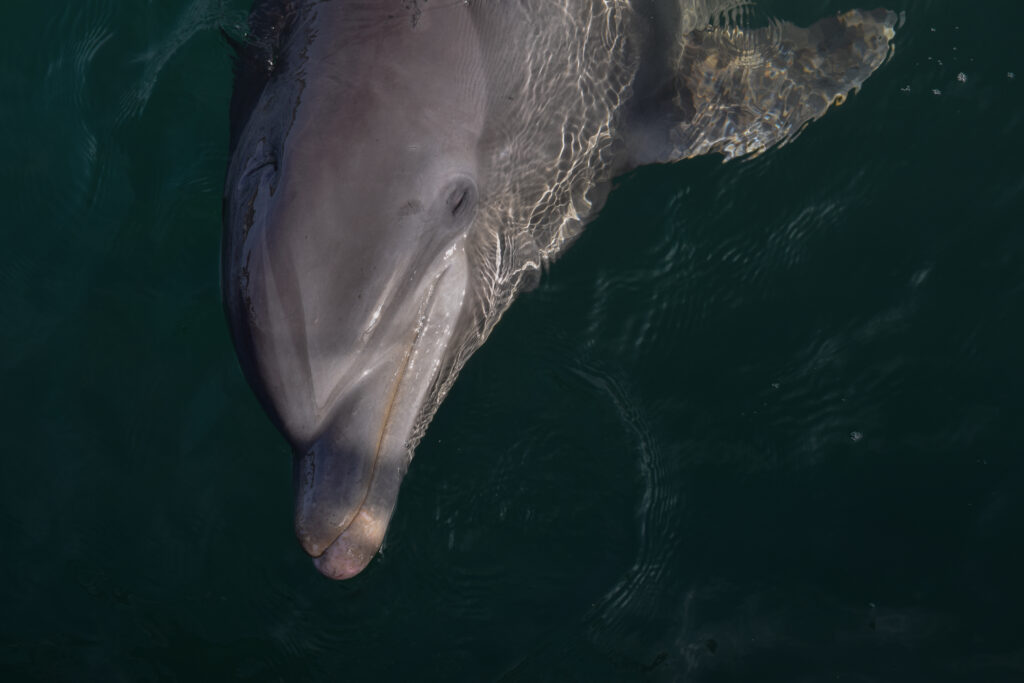
Dolphins sleep with one eye open, a behavior known as unihemispheric slow-wave sleep. Only one half of their brain sleeps at a time, while the other half remains alert. This adaptation allows them to continue swimming, breathe consciously, and remain vigilant for potential threats while still getting necessary rest.
During this type of sleep, dolphins often swim slowly or “rest” near the surface of the water. They may also engage in a behavior called “logging,” where they float motionless at the surface. The duration of sleep for each brain hemisphere can vary, but typically lasts for about two hours before switching. This unique sleep pattern is shared by other cetaceans and some bird species, demonstrating convergent evolution in animals that need to remain partially alert at all times.
7. What is the approximate gestation period for most dolphin species?
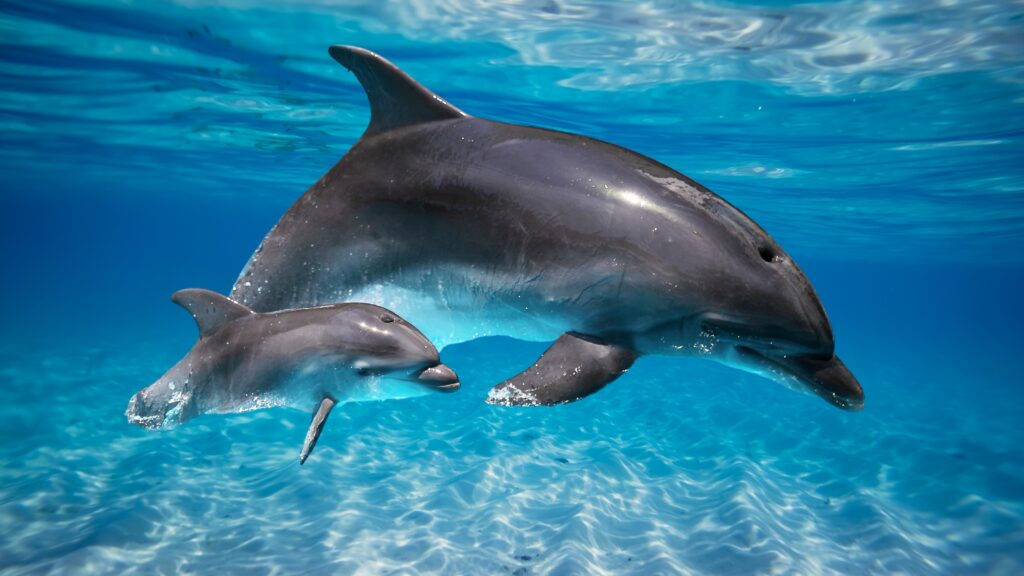
The reproductive biology of dolphins is a crucial aspect of their life history and population dynamics. Understanding the gestation period of dolphins provides insights into their breeding cycles, the investment they make in their offspring, and the challenges they face in successfully raising their young. This question explores an important aspect of dolphin reproduction that influences their social structure, behavior, and conservation needs.
A) 3-4 months
B) 6-7 months
C) 11-12 months
D) 15-16 months
Answer: C)
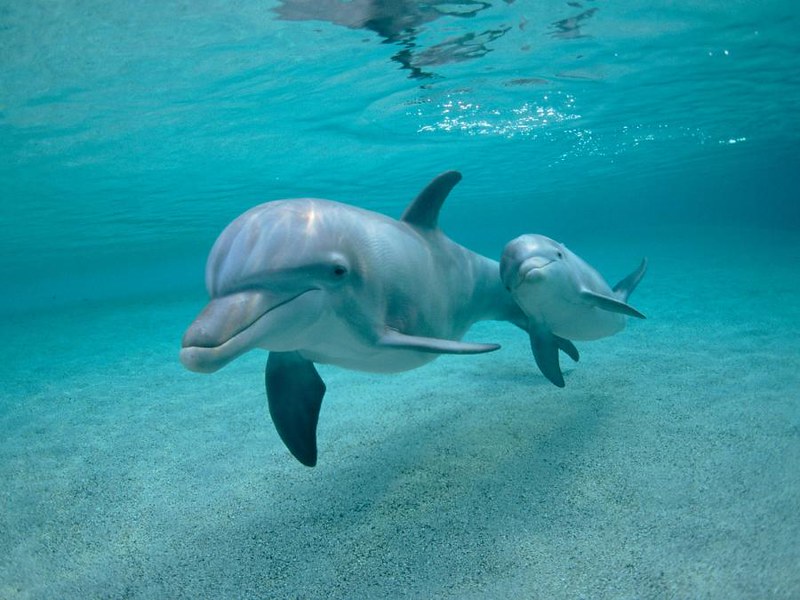
The approximate gestation period for most dolphin species is 11-12 months. This relatively long pregnancy contributes to their slow reproductive rate. After birth, calves stay with their mothers for 3-6 years, learning essential survival skills. This extended maternal care is crucial for the survival of young and transmission of cultural knowledge.
The investment in a single offspring at a time, combined with the long gestation and care period, reflects the complex social structure and cognitive abilities of dolphins. This reproductive strategy, while slow, ensures that each calf has the best possible chance of survival and contributes to the long-term stability of dolphin populations. However, it also makes dolphins vulnerable to population declines if adult survival rates are impacted by human activities or environmental changes.
8. True or False: Dolphins have hair.
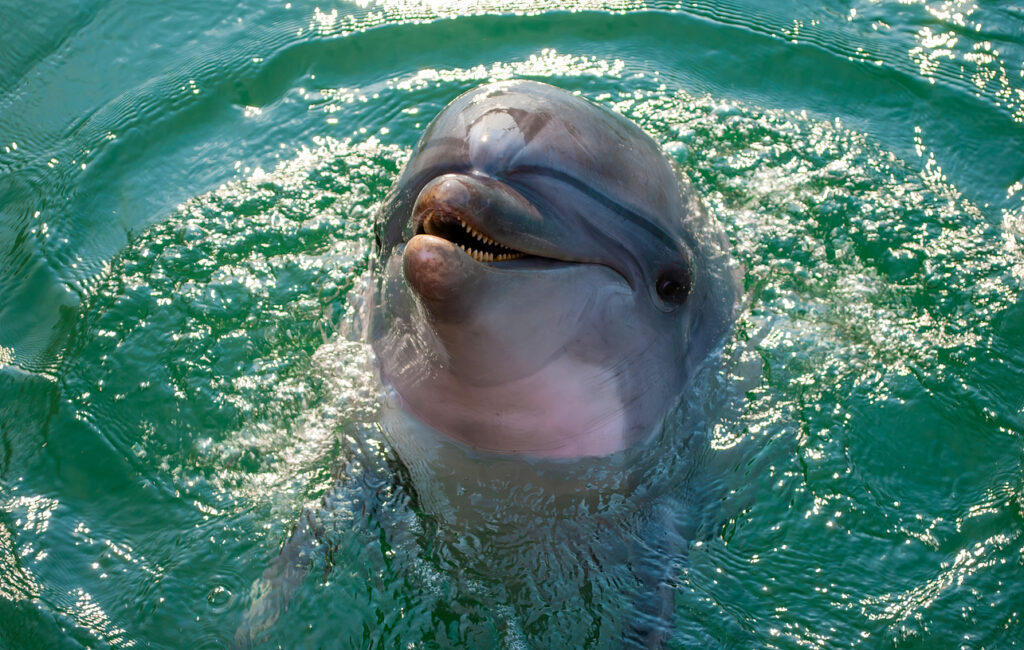
When we think of dolphins, their smooth, sleek bodies don’t typically bring to mind the idea of hair. However, this question delves into an interesting aspect of dolphin biology that connects them to their evolutionary past as land mammals. Exploring the presence or absence of hair in dolphins provides insights into their adaptation to aquatic life and the vestiges of their terrestrial ancestry that still remain.
Answer: TRUE
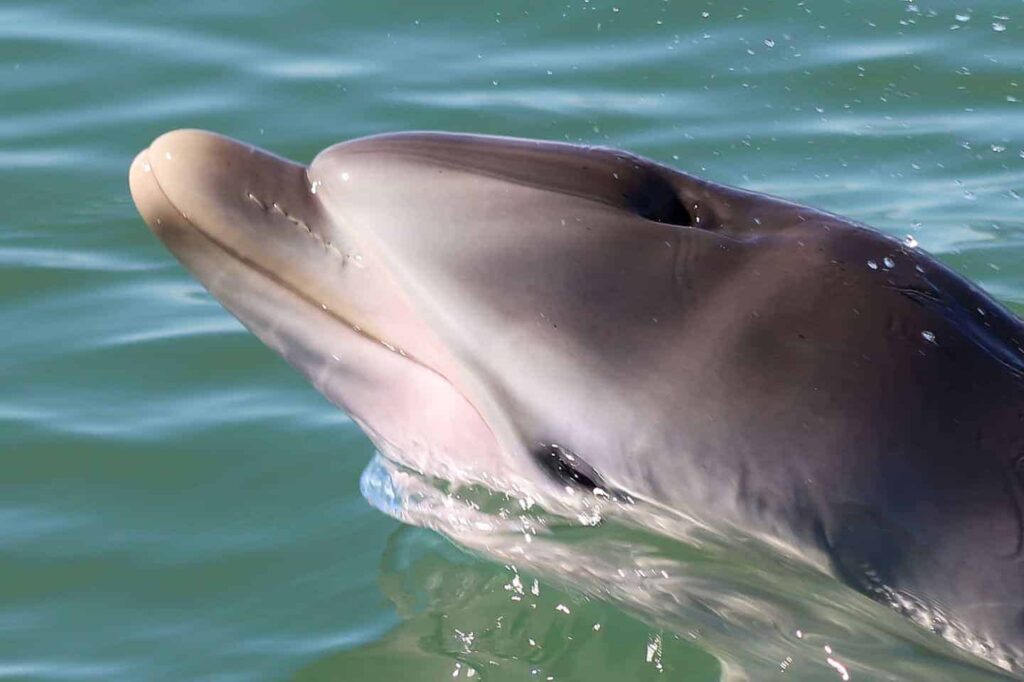
True. Dolphins do have hair, but it’s very limited and usually only present during early life stages. Most species are born with a few bristly hairs on their rostrum (snout), which typically fall out shortly after birth. This vestigial trait reflects their evolutionary history as land mammals that returned to the sea.
The presence of hair in dolphins is a vestigial trait, reflecting their evolutionary history as land mammals that returned to the sea. Over millions of years, dolphins have lost most of their body hair as an adaptation to their aquatic lifestyle, where hair would increase drag while swimming. However, the sensory follicles associated with these hairs remain and may play a role in detecting changes in water pressure or movement, similar to the function of whiskers in other mammals.
9. Which adaptation helps dolphins conserve oxygen while diving?
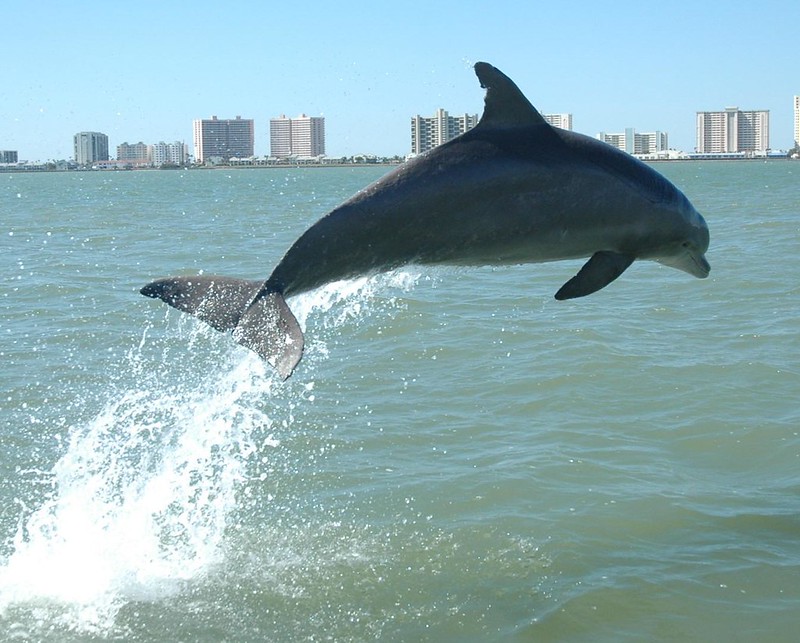
Dolphins are renowned for their diving abilities, often plunging to impressive depths in search of food or to avoid predators. This question explores one of the key adaptations that allows dolphins to excel in their underwater environment. Understanding how dolphins manage their oxygen supply during dives provides insights into their physiology and the evolutionary processes that have shaped these marine mammals.
A) Gills
B) Collapsible lungs
C) Extra large heart
D) Multiple stomachs
Answer: B)

Collapsible lungs help dolphins conserve oxygen while diving. As water pressure increases during a dive, their lungs compress, forcing air into the upper airways. This prevents nitrogen absorption into the bloodstream, avoiding decompression sickness. Other adaptations include higher muscle myoglobin concentration, slowed heart rate, and selective vasoconstriction.
These adaptations allow some dolphin species to dive to depths of over 1,000 meters and stay underwater for up to 15 minutes. The combination of collapsible lungs, higher muscle myoglobin concentration, slowed heart rate, and selective vasoconstriction enables dolphins to manage their oxygen supply efficiently during deep dives.
10. What is the name of the horizontal tail fin of a dolphin?
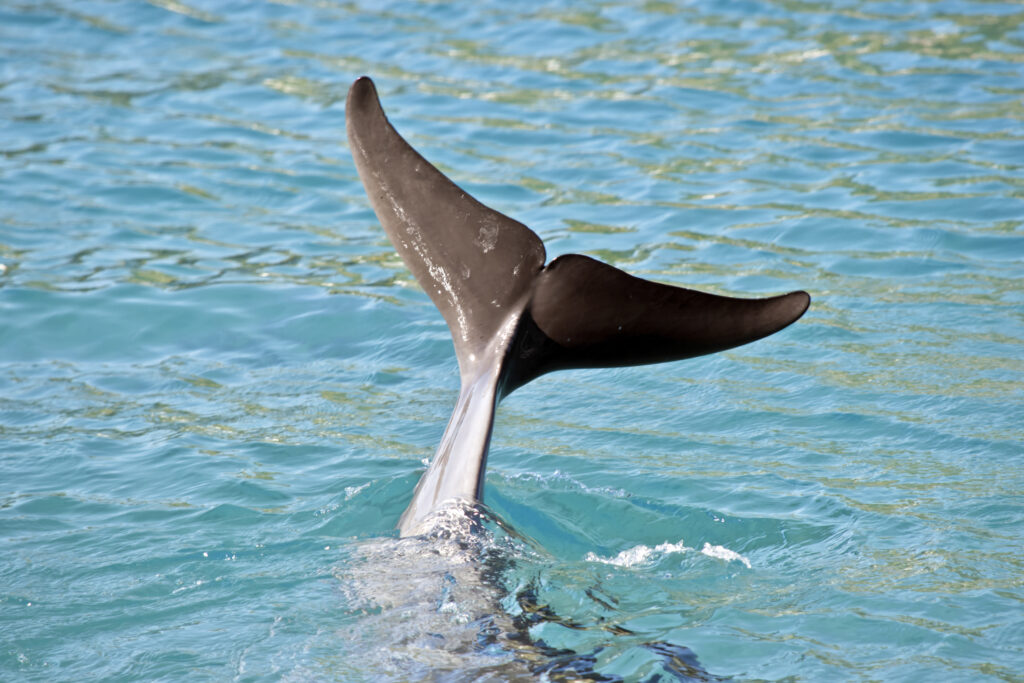
The distinctive tail of a dolphin is one of its most recognizable features, playing a crucial role in its movement through water. This question focuses on the specific terminology used to describe this important appendage. Understanding the structure and function of a dolphin’s tail provides insights into their swimming mechanics, energy efficiency, and evolutionary adaptations to aquatic life.
A) Fluke
B) Flipper
C) Fin
D) Tail
Answer: A)

The horizontal tail fin of a dolphin is called a fluke. Unlike fish with vertical tail fins, dolphins have horizontal flukes, reflecting their evolution from land mammals. The fluke is made of dense, fibrous connective tissue, allowing for flexibility and efficient swimming. Its shape and size vary between species, adapting to different marine environments.
The fluke is a powerful and flexible appendage that propels the dolphin through the water. It’s made of dense, fibrous connective tissue, not bone, which allows for greater flexibility and efficiency in swimming. The shape and size of flukes can vary between species, reflecting adaptations to different marine environments and swimming styles. Species that frequently engage in deep diving often have larger flukes relative to their body size, providing more power for vertical movement.
11. How many species of dolphins are currently recognized?

The diversity of dolphin species around the world is a testament to their evolutionary success and adaptability. This question explores the current state of dolphin taxonomy, reflecting ongoing research and discoveries in marine biology. Understanding the number and variety of dolphin species provides insights into their global distribution, ecological roles, and the conservation challenges facing different populations.
A) About 20
B) About 40
C) About 60
D) About 80
Answer: B)

Currently, there are approximately 40 recognized species of dolphins. This number includes both oceanic and river dolphins. The exact count can vary slightly depending on taxonomic classifications and new discoveries. Dolphins belong to the family Delphinidae, the largest family within the order Cetacea, showcasing their diversity.
The diversity of dolphin species is remarkable, ranging from the tiny 4-foot-long Maui’s dolphin to the impressive orca (killer whale), which can grow up to 32 feet in length. These species inhabit a wide range of aquatic environments, from shallow coastal waters to deep oceanic regions and even some river systems. Each species has evolved unique adaptations to its specific habitat, resulting in variations in size, coloration, behavior, and ecological niches.
12. What is the primary diet of most dolphin species?
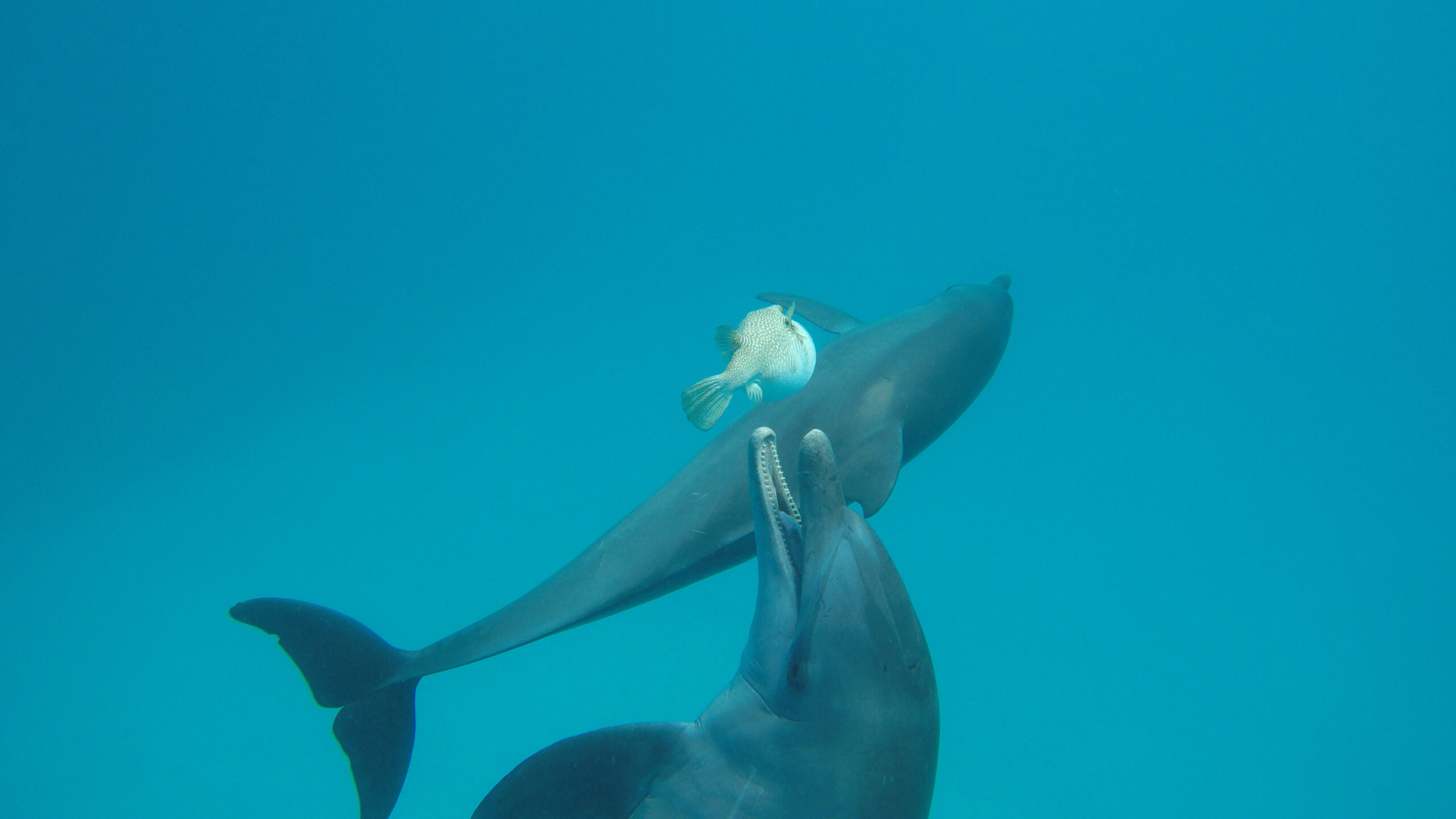
The feeding habits of dolphins are a crucial aspect of their biology and behavior, influencing everything from their social structures to their migration patterns. This question delves into the dietary preferences of these marine mammals, providing insights into their role in ocean ecosystems and the adaptations they’ve developed for hunting and foraging. Understanding dolphin diets is also essential for conservation efforts and managing the health of marine environments.
A) Seaweed and algae
B) Fish and squid
C) Plankton
D) Crustaceans
Answer: B)
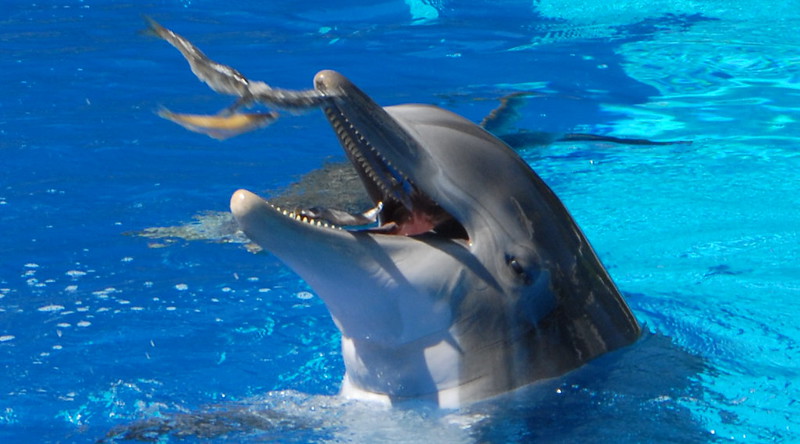
The primary diet of most dolphin species consists of fish and squid. However, specific dietary preferences vary widely depending on the species, habitat, and available prey. Dolphins are opportunistic feeders and may consume a variety of marine life, including crustaceans and octopuses. Some species have developed unique hunting techniques.
Dolphins have developed sophisticated hunting techniques to catch their prey. Many species use echolocation to locate food, while others employ cooperative hunting strategies within their pods. Some coastal dolphin populations have been observed using unique feeding methods, such as “strand feeding,” where they temporarily beach themselves to catch fish.
13. Which dolphin species is known for its pink coloration?

Dolphin species exhibit a wide range of colors and patterns, but one species stands out for its unique pink hue. This question highlights the diversity among dolphin species and the special adaptations that have evolved in different environments. The distinctive coloration of this particular species has made it a subject of fascination for both scientists and the general public.
A) Bottlenose dolphin
B) Spinner dolphin
C) Amazon River dolphin
D) Risso’s dolphin
Answer: C)

The Amazon River dolphin, also known as the boto or pink river dolphin, is known for its pink coloration. This unique hue can vary in intensity and is more pronounced in males. The pink color is believed to be caused by blood vessels near the skin surface and may intensify with increased activity.
These freshwater dolphins are found in the Amazon and Orinoco river basins of South America. Their pink coloration is not present at birth but develops as they age. The intensity of the pink can vary from pale to vivid, and it’s thought that the color may play a role in social interactions. Amazon River dolphins face significant conservation challenges due to habitat loss, pollution, and accidental capture in fishing gear, making them an important focus for river ecosystem conservation efforts.
14. How do dolphins communicate with each other?
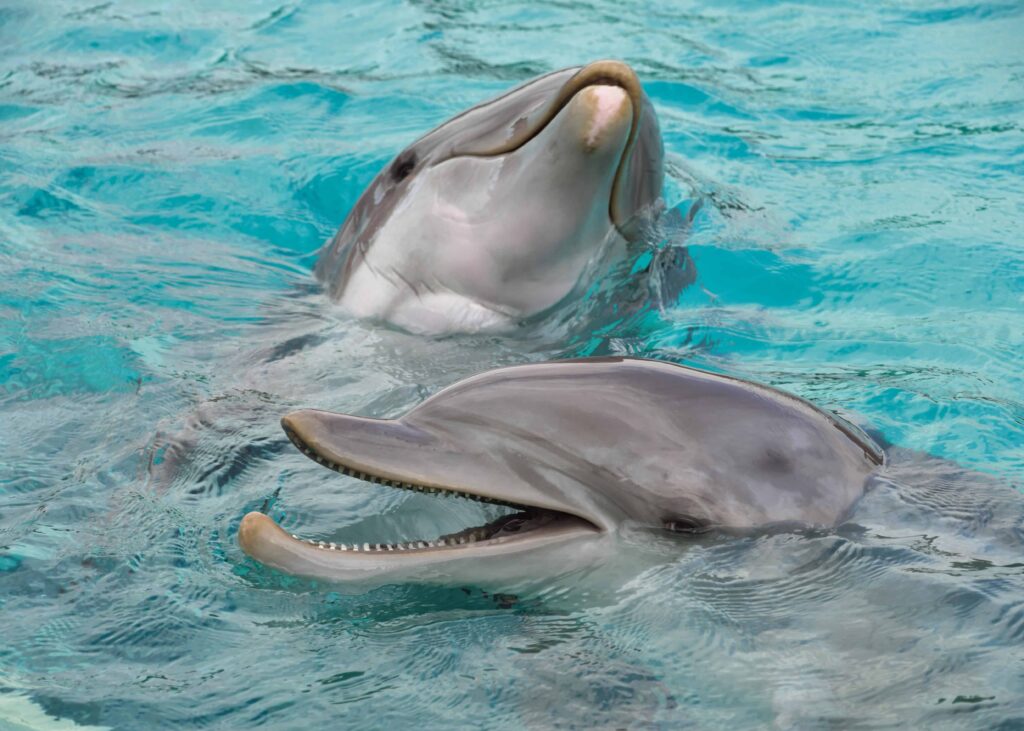
Communication is a vital aspect of dolphin social life and survival. This question explores the various methods dolphins use to interact with each other, coordinate activities, and share information. Understanding dolphin communication provides insights into their cognitive abilities, social structures, and the complexity of their underwater world.
A) Only through echolocation
B) Only through body language
C) Through vocalizations, body language, and physical contact
D) Only through pheromones
Answer: C)
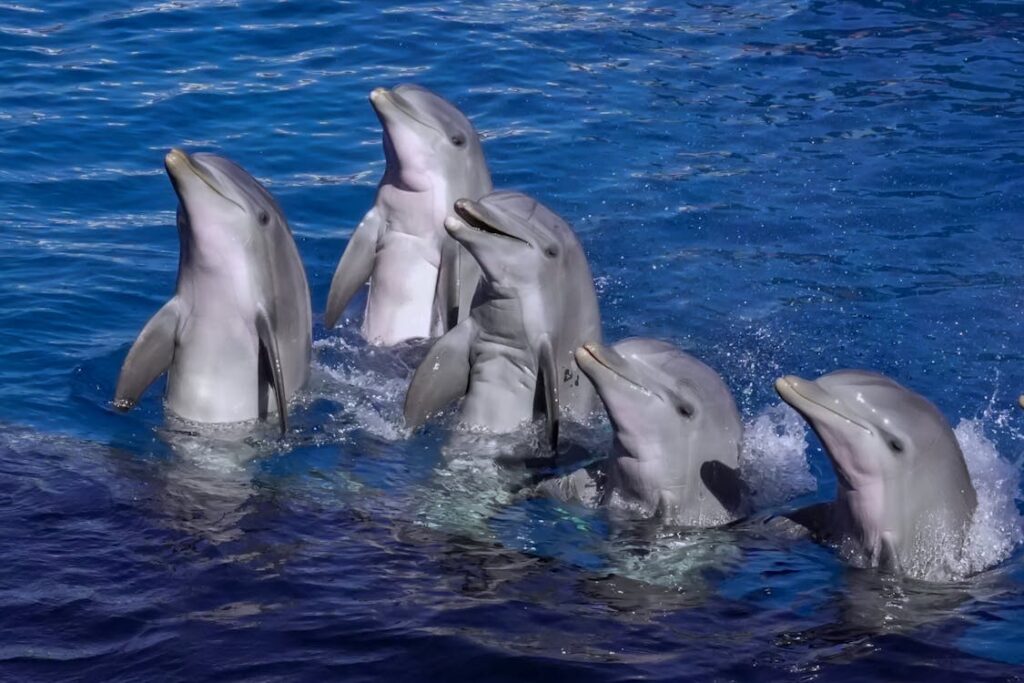
Dolphins communicate through a combination of vocalizations, body language, and physical contact. Their vocalizations include clicks, whistles, and pulsed sounds. They also use body postures, jaw claps, bubble blowing, and tactile behaviors like rubbing to convey messages. This complex communication system supports their social structures and cooperative behaviors.
Each dolphin has a unique signature whistle, which acts like a name, allowing individuals to identify each other. They can also mimic the whistles of other dolphins, suggesting a sophisticated level of vocal learning. Echolocation clicks, while primarily used for navigation and hunting, also play a role in communication. Body language, such as tail slaps, breaches, and fin slaps, can convey emotions or serve as warnings.
15. What is the average swimming speed of a dolphin?

Dolphins are known for their agility and speed in the water. This question addresses a fundamental aspect of dolphin physiology and behavior, exploring how these marine mammals move through their aquatic environment. Understanding dolphin swimming speeds provides insights into their hunting abilities, energy expenditure, and adaptations for life in the water.
A) 3-5 mph
B) 8-11 mph
C) 15-20 mph
D) 25-30 mph
Answer: B)
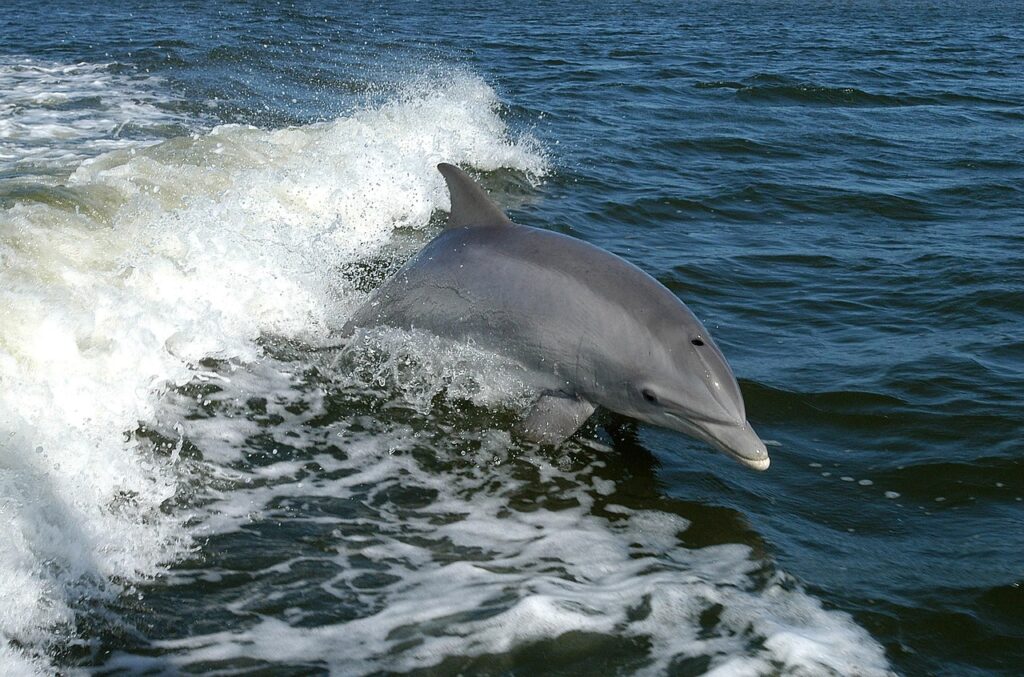
The average swimming speed of a dolphin is about 8-11 mph (13-18 km/h). However, they can reach burst speeds of up to 25 mph (40 km/h) when chasing prey or escaping predators. Different species have varying speed capabilities, with some, like the orca, capable of even higher speeds.
Dolphins achieve their impressive speeds through a combination of powerful tail flukes, streamlined body shapes, and smooth skin that reduces drag in the water. Their swimming efficiency is further enhanced by a layer of blubber that smooths out the contours of their bodies. Some species, like the common dolphin, are known for their acrobatic abilities, frequently leaping out of the water in displays of speed and agility.
16. True or False: Dolphins are born tail-first

The birth process of marine mammals like dolphins is a fascinating aspect of their biology, adapted to the challenges of an aquatic environment. This question explores a unique characteristic of dolphin births that ensures the survival of newborn calves. Understanding this aspect of dolphin reproduction provides insights into their evolutionary adaptations and the critical first moments of a dolphin’s life.
Answer: TRUE
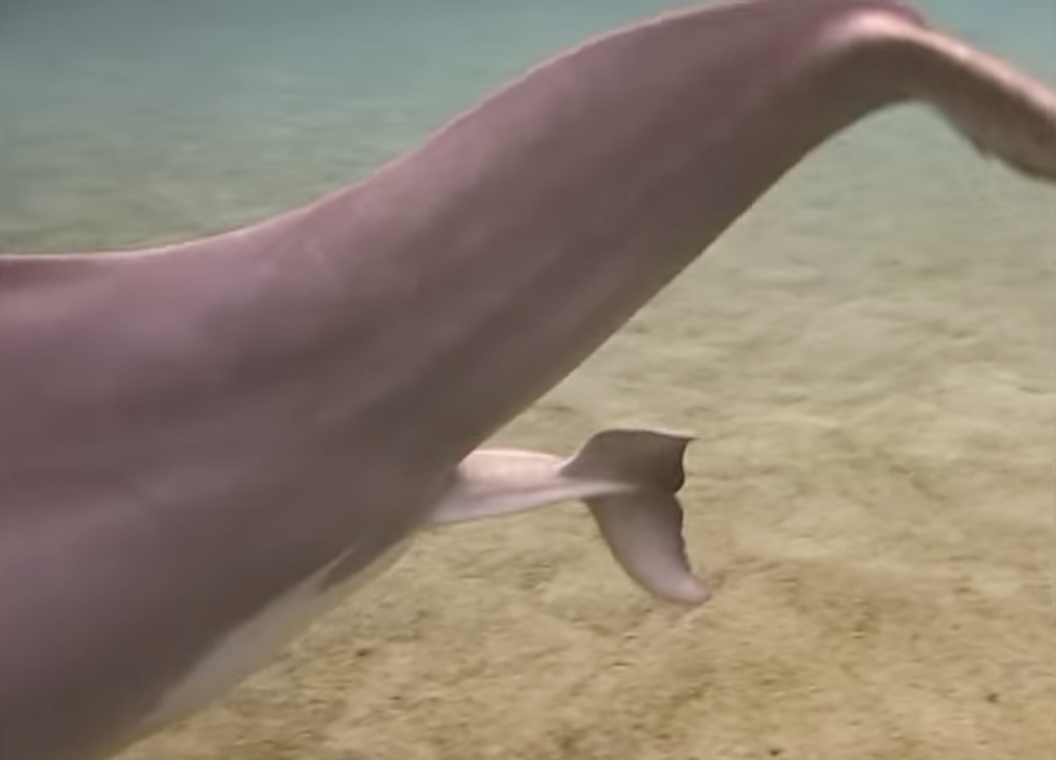
True. Dolphins are born tail-first, which is unusual for mammals but common among cetaceans. This birth position ensures that the calf can quickly surface for its first breath, reducing the risk of drowning. The mother often assists the newborn to the surface for its initial breath of air.
This tail-first birth is a crucial adaptation for aquatic mammals. It allows the calf’s tail to emerge first, giving it the ability to propel itself to the surface if necessary. The mother typically positions herself near the surface during birth and may be assisted by other female dolphins, known as “aunties,” who help protect the mother and newborn during this vulnerable time. This birthing strategy demonstrates the remarkable evolutionary adaptations of dolphins to their marine environment.
17. Which sense is generally considered to be the weakest in dolphins?
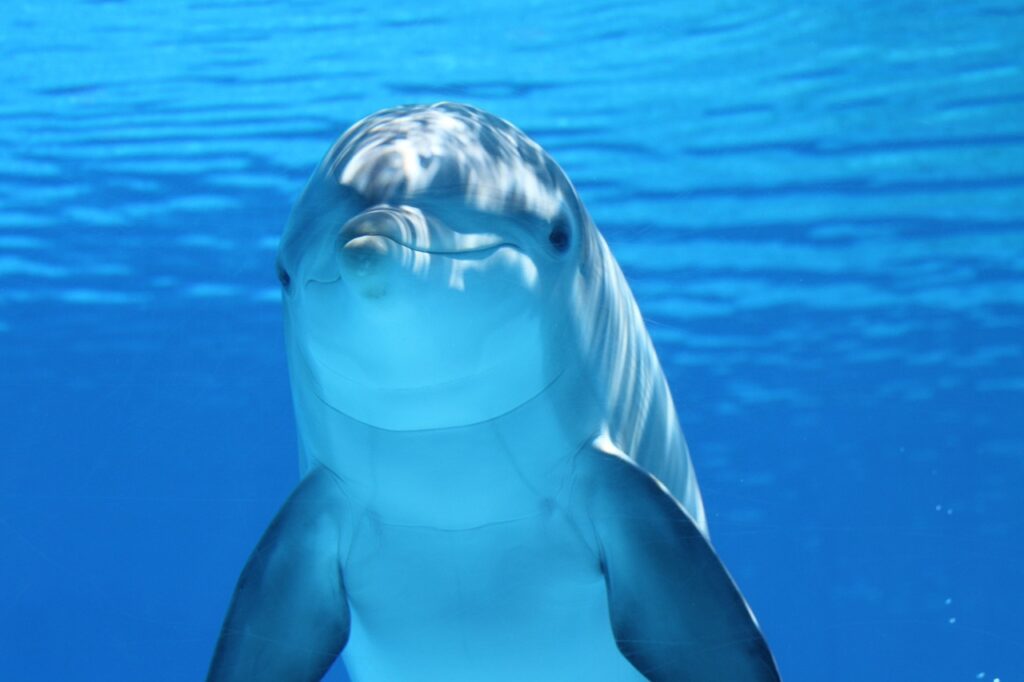
Dolphins are known for their keen senses, particularly their exceptional hearing and echolocation abilities. However, not all of their senses are equally developed. This question explores an aspect of dolphin physiology that has been shaped by their aquatic lifestyle and evolutionary history, highlighting how their sensory capabilities have adapted to underwater life.
A) Sight
B) Hearing
C) Touch
D) Smell
Answer: D)
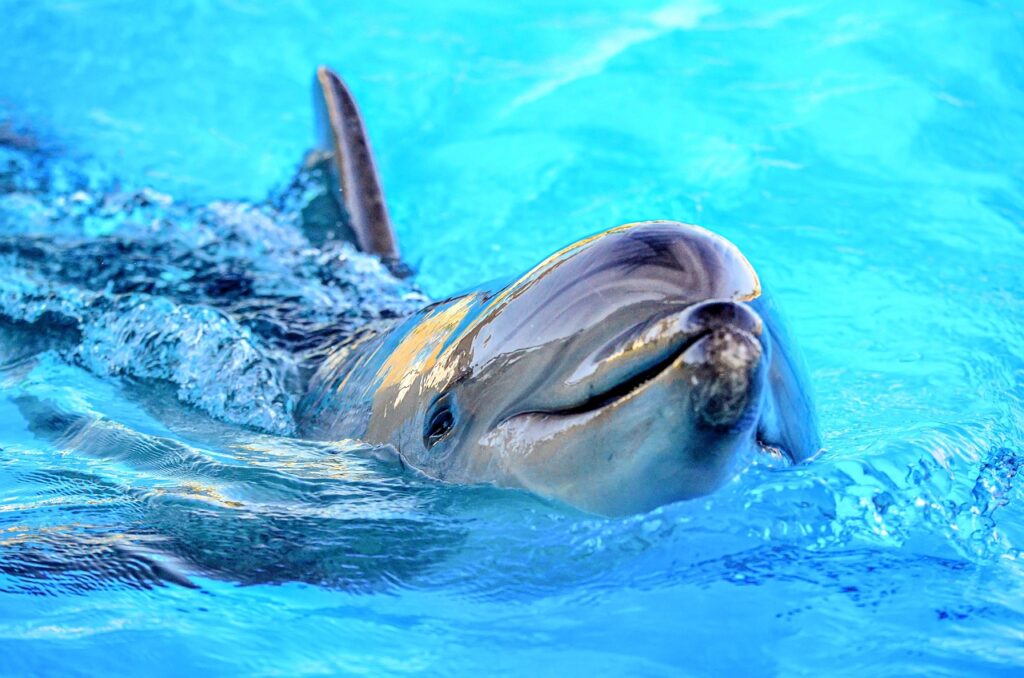
The sense of smell is generally considered the weakest in dolphins. Most dolphin species lack olfactory lobes and nerves, rendering them unable to smell in the traditional sense. However, they compensate with highly developed echolocation abilities and good eyesight, both above and below water.
The loss of smell in dolphins is an evolutionary adaptation to life in water, where airborne scents are less relevant. Instead, they rely heavily on their acute hearing and echolocation for detecting prey, navigating, and communicating. Their eyesight is also well-developed, with eyes adapted to see clearly both in air and water. Some scientists believe that dolphins may have a form of chemoreception through taste buds in their mouths, which could serve some of the functions typically associated with smell in other animals.
18. What is the purpose of a dolphin’s blowhole?
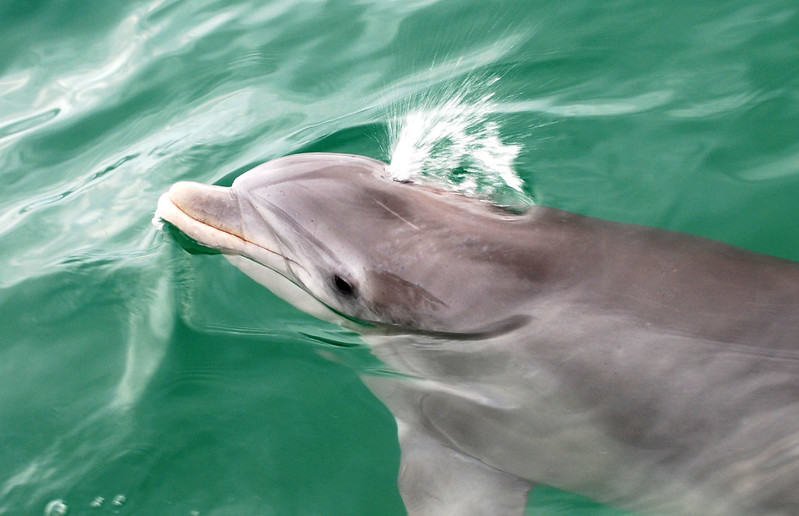
The blowhole is one of the most distinctive features of dolphins and other cetaceans. This question addresses a fundamental aspect of dolphin anatomy and physiology, exploring how these marine mammals have adapted to breathe air while living in an aquatic environment. Understanding the function of the blowhole provides insights into the evolutionary changes that allowed dolphins to thrive in the ocean.
A) Breathing
B) Echolocation
C) Feeding
D) Communication
Answer: A)
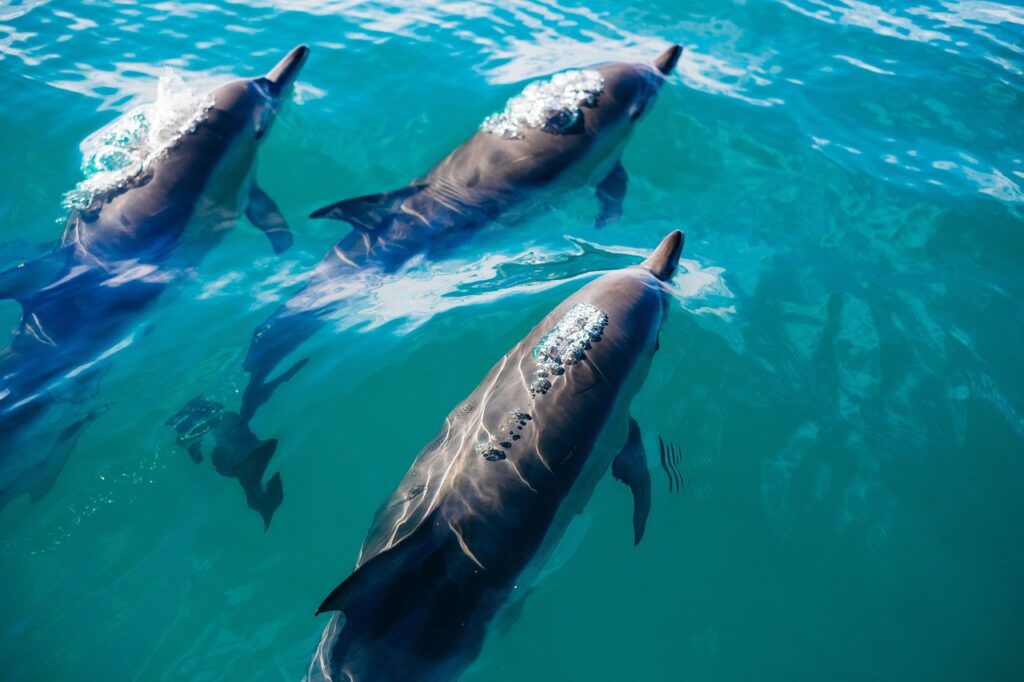
A dolphin’s blowhole is used for breathing. It’s essentially a nostril that has migrated to the top of the head, allowing the dolphin to breathe while mostly submerged. When a dolphin surfaces, it exhales forcefully through the blowhole before taking a quick inhalation and diving again.
The position of the blowhole on top of the head is a key adaptation that allows dolphins to breathe efficiently at the water’s surface with minimal body exposure. This reduces energy expenditure and vulnerability to predators. The blowhole is sealed by strong muscles when the dolphin is underwater, preventing water from entering the lungs. The forceful exhalation not only clears water from the blowhole but also creates the characteristic spout often associated with cetaceans.
19. How many teeth does an average adult bottlenose dolphin have?
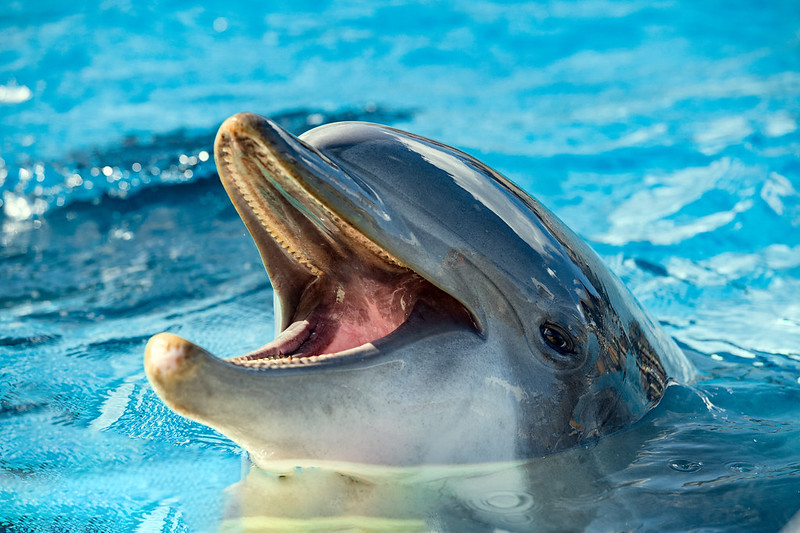
Dolphin dentition is an interesting aspect of their anatomy that reflects their feeding habits and evolutionary history. This question explores the dental characteristics of one of the most well-known dolphin species, providing insights into how dolphins catch and process their food. Understanding dolphin teeth also offers clues about their diet and their place in marine food webs.
A) 20-40
B) 80-100
C) 150-200
D) 250-300
Answer: B)

An average adult bottlenose dolphin has between 80 and 100 teeth. These conical-shaped teeth are designed for grasping prey rather than chewing. Dolphins swallow their food whole, using their teeth primarily to catch and hold onto slippery fish and squid before swallowing them.
Unlike human teeth, dolphin teeth are all roughly the same shape – conical and pointed. This uniform dentition is well-suited for catching fish, squid, and other slippery prey. Interestingly, dolphins do not use their teeth to chew or break down food. Instead, they use them to grip prey before swallowing it whole. The number and arrangement of teeth can vary among dolphin species, reflecting differences in diet and feeding strategies. Some species, like the risso’s dolphin, may have fewer teeth, while others, like the spinner dolphin, can have over 250 teeth.
20. What is the largest species of dolphin?
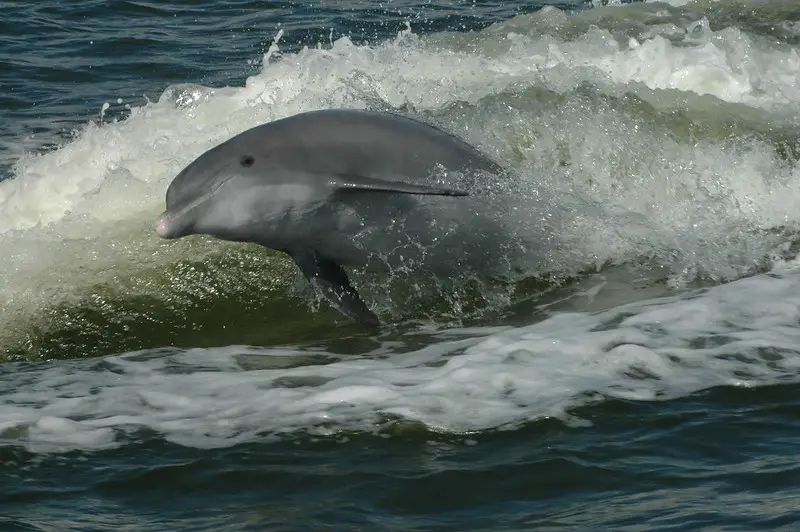
This is a slightly trick question or maybe just will be a surprise. The dolphin family includes a wide range of species with varying sizes. This question highlights the diversity within the dolphin family and addresses a common misconception about the classification of certain marine mammals. Understanding the size range of dolphins provides insights into their evolution, ecological roles, and the challenges they face in conservation efforts.
A) Bottlenose dolphin
B) Orca (Killer Whale)
C) Spinner dolphin
D) Risso’s dolphin
Answer: B)

The largest species of dolphin is the orca, or killer whale. Despite its name, the orca is a member of the dolphin family. Adult male orcas can grow up to 32 feet (9.8 meters) in length and weigh up to 22,000 pounds (10,000 kg), making them significantly larger than any other dolphin species.
Orcas are apex predators and have a diverse diet that can include fish, seals, and even other whales, depending on the population and region. Their large size, combined with their intelligence and social structure, makes them formidable hunters. Orcas are found in all the world’s oceans, from the Arctic to the Antarctic, and display a range of cultural behaviors that vary between populations. Despite being the largest dolphin, they are highly agile and capable of impressive bursts of speed, reaching up to 34 mph (56 km/h) in short sprints.
21. Which of these is NOT a type of dolphin?
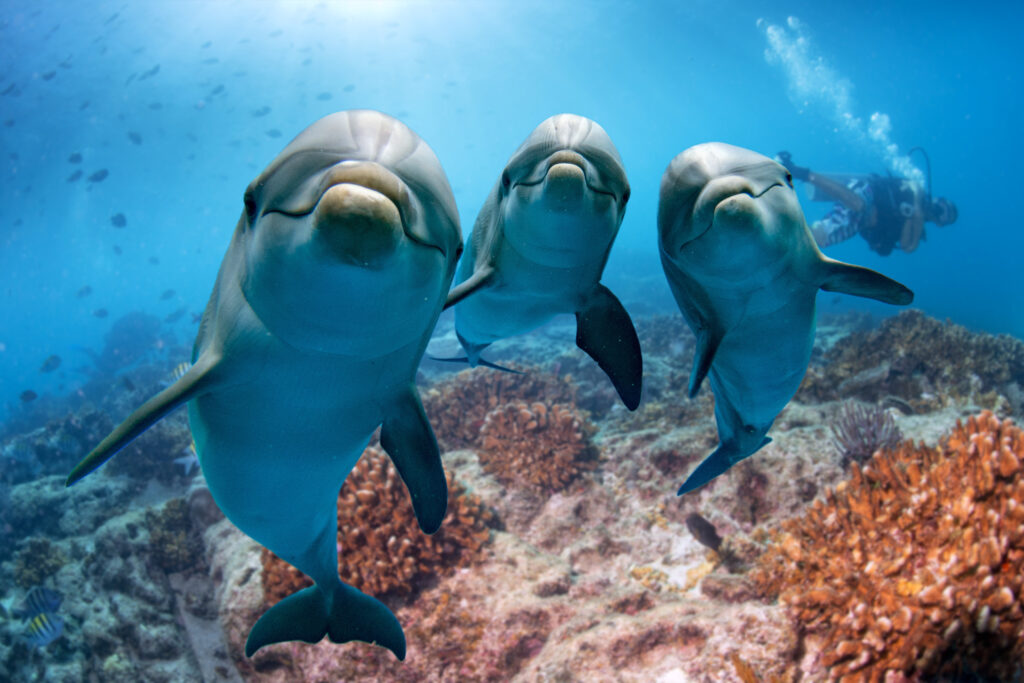
The diversity within the cetacean order, which includes all whales, dolphins, and porpoises, is often surprising to many people. This question challenges our understanding of dolphin classification and highlights the sometimes unexpected relationships between different marine mammals. Exploring the distinctions between these species provides insights into the evolutionary history of cetaceans.
A) Orca (Killer Whale)
B) Narwhal
C) Amazon River Dolphin
D) Beluga Whale
Answer: B)

The correct answer is B) Narwhal. While orcas, Amazon River dolphins, and beluga whales are all members of the dolphin family (Delphinidae), narwhals belong to a different family called Monodontidae. They are more closely related to belugas than to other dolphins. This highlights the diversity within the cetacean order.
Many people are surprised to learn that orcas are actually the largest member of the dolphin family, reaching lengths of up to 32 feet and weighing up to 6 tons. The Amazon River dolphin, also known as the boto, is one of the few freshwater dolphin species, adapted to life in the complex river systems of South America. Beluga whales, with their distinctive white coloration and bulbous forehead, are often called “sea canaries” due to their wide range of vocalizations.
22. True or False: Dolphins can recognize themselves in mirrors.
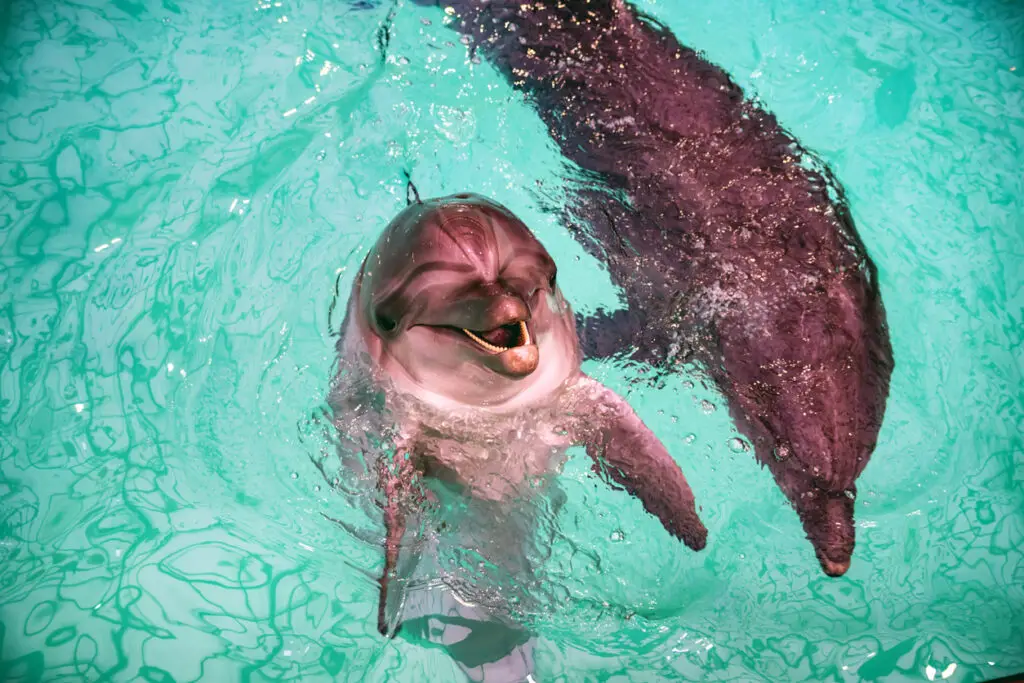
Self-awareness is a cognitive trait associated with higher intelligence, and its presence in non-human animals has been a subject of significant scientific interest. This question explores an aspect of dolphin cognition that relates to their self-awareness and intelligence. Understanding whether dolphins can recognize themselves provides insights into their cognitive abilities and their place among the most intelligent animals on Earth.
Answer: TRUE

True. Dolphins can recognize themselves in mirrors, demonstrating self-awareness. This ability has been observed in bottlenose dolphins through mirror self-recognition tests, where they exhibit behaviors indicating they understand the reflection is their own image. This cognitive skill is shared by only a few other animal species.
Mirror self-recognition is considered a sign of self-awareness and has been demonstrated in only a handful of species, including great apes, elephants, and magpies. In experiments, dolphins have been observed using mirrors to inspect parts of their bodies they can’t normally see, and they’ve shown interest in marks placed on their bodies that are only visible in the mirror. This ability suggests a level of cognitive sophistication that goes beyond simple intelligence, implying that dolphins have a sense of self and potentially a form of consciousness.


